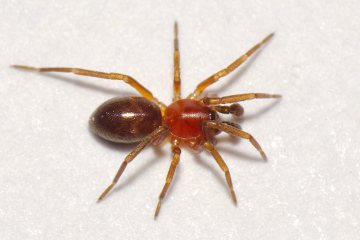Summary for Phrurolithus minimus (Araneae)
previous species | next species
National Distribution
Terms of Use. Double-click on map to go to region

Explore Regional Distribution
Please log on and add a note on this species
About this species
Recorded altitude range0m to 700m
Species text
DistributionThe species is largely confined to the south of England mainly in the south-east. There is one record from Staffordshire and a recent record from Cumbria. It is fairly widespread in north-western and central Europe, but has not been recorded from Ireland and is scarce in Scandinavia.
Habitat and ecology
P. minimus occurs in grassland, mainly on chalk, usually in stony, sparsely vegetated areas, but it has also been found in open woodland areas on sand, in dry litter at the edge of woodland rides and coppice areas. It is found under stones or running in sunshine. Adult males are found mainly from late spring to mid-summer, females from May to August.
Status
The spider is very local, with most records from the North Downs area and the Isle of Wight. It is absent from many apparently suitable chalk grassland areas. However, the recent record from Cumbria suggests it might have been overlooked further north, perhaps due to its small size and similarity to the commoner P. festivus.
Threats
The loss of chalk grassland to agriculture, and loss of sparsely vegetated areas by reduction of grazing.
Management and conservation
Possibly maintain open stony areas by grazing, but it may occur mainly in areas that would remain sparsely vegetated anyway because of lack of soil.
Text based on Dawson, I.K., Harvey, P.R., Merrett, P. & Russell-Smith, A.R. (in prep.). References
Adult Season
Habitats
background methodology
Recorded management for locations with Phrurolithus minimus
Recorded substrate and hydrology for locations with Phrurolithus minimus
Images
please log on and upload a new image for this speciesSee also A-Z Species Index - A-Z Picture Index - previous species | next species
